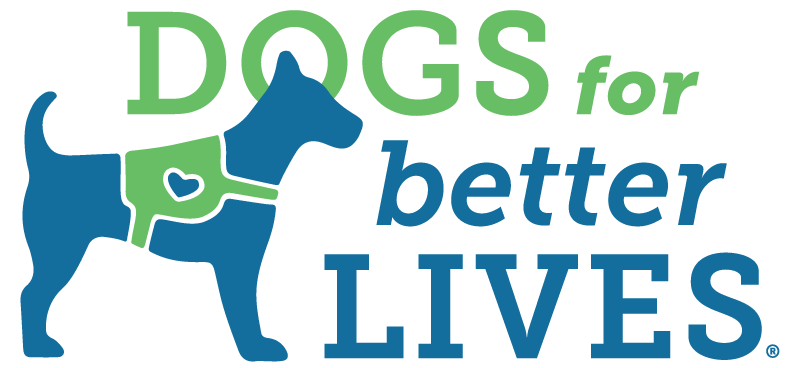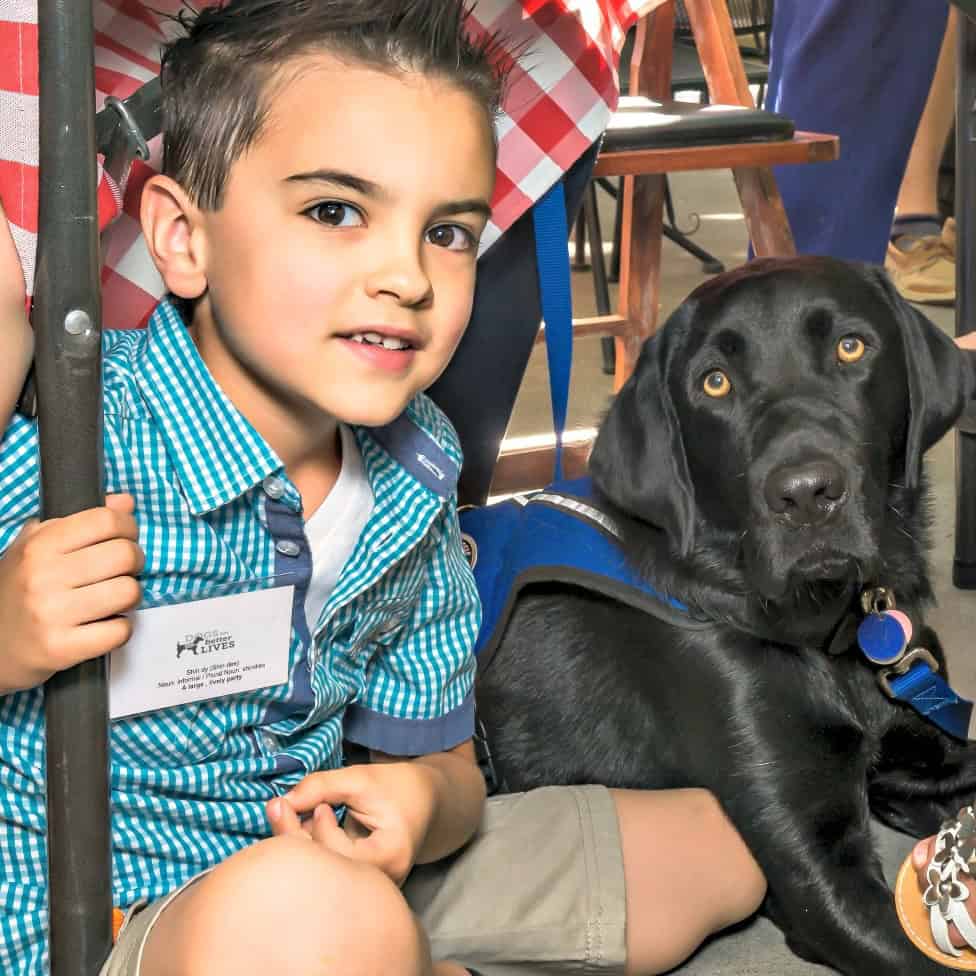Where are you currently placing Autism Assistance Dogs?
Due to the high volume of applicants, we are currently not accepting new applications. We expect to re-open the application process in 2025. Thank you for your interest in our program.
We are currently placing Autism Assistance Dogs in California, Connecticut, Maine, Massachusetts, New Hampshire, New York, Oregon, Rhode Island, Vermont, and Washington,
Over the next several years, the program will continue to grow and will eventually be available nationwide.
What does it cost to get an Autism Assistance Dog?
There is no charge to receive an Autism Assistance Dog.
Career Change Dogs
Can I adopt a dog from Dogs for Better Lives?
Occasionally we have Career Change Dogs up for adoption. Career Change Dogs are wonderful dogs that are just not suited to working for a living. You can keep an eye on our Career Change Dogs page to watch for adoptable dogs as they become available. Please note that while all applications are received and reviewed, not all applicants will be contacted to continue in the application process.
What does it cost to get a Career Change Dog?
There is a requested donation or fee required to receive a Career Change Dog. Adoption fees are set by DBL.
How do I apply for a Career Change Dog?
Please visit our Career Change Dogs page to apply.
Hearing Dogs
What does it cost to get a Hearing Dog?
There is no charge to receive a Hearing Dog.
What sounds are the dogs trained to respond to?
Dogs are trained to respond to a variety of household sounds, including: the doorbell/knock, smoke alarm, alarm clock, telephone, name call, and oven timer.
Why would a person who is Deaf or hard of hearing need a dog in public?
Deafness and hearing loss are invisible – many people feel more secure and confident in public with their dog beside them. The dog helps others realize that the person is Deaf or hard of hearing and might need help in an emergency and that is necessary to face the person to communicate. Additionally, paying attention to the dog’s natural reactions to the world around it, the person may gain greater environmental awareness.
Are the Hearing Dogs trained in ASL (American Sign Language)?
No, they are not. Our dogs are trained to sounds and to alert their hearing impaired partner to sounds in the home, such as a door knock, oven timer, doorbell, telephone, smoke alarm, and even a baby’s cry. If the person signs, the dog will learn it very quickly. We do teach obedience commands with voice and hand signals.
What is the age requirement to be considered for a Hearing Dog?
We do not place Hearing Dogs with applicants under the age of 18 years.
How long do people typically wait before a Hearing Dog is placed?
The current expected wait time is approximately 36 months.
How do I apply for a Hearing Dog?
Before applying for a Hearing Dog, you need to decide if you would benefit from having a Hearing Dog in your life. Please review the Hearing Dog page to learn more about our requirements and application process.
Facility Dogs
What does it cost to get a Facility Dog?
There is no charge to receive a Facility Dog.
What is a Facility Dog trained to do?
Facility Dogs are trained to be calm and relaxed regardless of what is going on around them. These dogs must remain quiet in order to help calm clients and patients of professionals who work with children and adults who have challenges or have disabilities. The dogs are trained to go to clients or students on command to help ease anxiety. Dogs can also be used as a reward for positive behavior.
How do I apply for a Facility Dog?
Before applying for a Facility Dog, you need to decide if you would benefit from having a Facility Dog in your life. After reviewing the application process, application requirements and points to consider, please visit our Facility Dog page to apply.
What is the age requirement to be considered for a Facility Dog?
Applicants must be adults who work with people who have physical, mental, or emotional challenges or disabilities. This may include: full-time physicians, teachers, counselors, licensed therapists or counselors, or volunteers who work in these settings.
How long do people typically wait before a Facility Dog is placed?
Ideally, most Facility Dogs are placed within 36 months from the time an applicant is approved, depending on a number of factors.
General Information
Can you train my dog to be an Assistance Dog?
We only train the dogs we directly rescue or breed. We select all of our dogs for training based on their temperament and ability. Dogs that go through our 4-6 months of training are then placed with pre-qualified clients.
Who do I contact about my donation? Partnership requests? Media opportunities?
General inquiries, including partnerships:
info@dogsforbetterlives.org
Help with a donation:
donorservices@dogsforbetterlives.org
Media inquiries:
sara@dogsforbetterlives.org
How are dogs and people matched?
Each applicant must go through a thorough screening and application process. Once chosen to receive a dog, the applicant is matched with the appropriate dog based on lifestyle, living situation and personality.
Where do you get the dogs that you train?
Most of our shelter dogs come from shelters, rescues, and humane societies in Oregon, Washington, and California. Our trainers visit the shelters and rescues looking for dogs with the very specific temperaments, thoroughly evaluating them to find the best fit.
The ideal candidate would be described as:
- Very easily handled, not resistant or fearful or physical touch or manipulation
- Doesn’t bolt in fear or pull towards distraction
- Will investigate a novelty without verbal encouragement
- High sociability, easily orients to people for direction without verbal coaxing
- Confident in new environments and easily adapts to new sights and sounds without signs of fear or reactivity
The remainder of our dogs are donated dogs or puppies from other Service or Assistance Dog organizations such as Guide Dogs for the Blind, and individual donors. DBL also has a small breeding program to assure we have enough dogs to serve the number of people in need of an Assistance Dog.
At what age do you start training the dogs?
The majority of the dogs begin training between 14 months and 3 years of age.
How long does the training take?
Generally, the dogs are in training from 4-6 months.
What are the selection criteria for the dogs you train?
The basic things we look for are confidence and friendliness. These traits are important for training and critical for a dog which may accompany our clients into public places. We use dogs of all sizes and look for dogs that are motivated by toys and treats.
How are the dogs trained?
The dogs are trained with positive reinforcement. The trainers reward good behavior and ignore undesirable behavior.
How can I become a trainer?
DBL’s apprenticeship program is three (3) year program. After attaining the needed skills and passing DBL’s certification test, Apprentice Trainer’s become Certified Assistance Dog Trainers. Excellent communication skills and teamwork are required. A history of working with dogs is a plus. If you are interested in becoming an assistance dog trainer, please visit our Careers page.
What are the dogs trained to do?
Please refer to the Hearing Dog, Facility Dog, and Autism Assistance Dog pages.
Can you train the dog to do specific tasks for the person?
Yes. All hearing dogs receive the same basic training and then each dog receives specialized training depending on the person’s sound work needs. Autism Assistance Dogs and Facility Dogs have training specialized for each client.
Can you certify my personal dog for public access?
We do not certify dogs that we have not trained.
How can I help Dogs for Better Lives?
Of course, financial support is very important, and you can help by making donations to Dogs for Better Lives. Donations of any size are very helpful and greatly appreciated. You can also help spread the word about the services Dogs for Better Lives provides – saving dogs and helping people. Telling friends, relatives, and business associates about us will increase the number of people who know about this very special organization. You could also put on a fundraiser in your local community and send the proceeds to Dogs for Better Lives. Visit the Donate section of the website to make a gift or learn about giving opportunities. Visit our Get Involved section to learn more about volunteer opportunities.
What does the dog have to do in order to graduate from the program?
They have to be obedience trained and trained in the skills needed by the client they are being placed with. They must perform their skills reliably and regardless of any distractions around them. Those dogs that will be going into public places must pass the Public Access Test from Assistance Dogs International.
What happens to dogs that are not able to complete the training?
Dogs that are not able to complete Hearing Dog, Autism Assistance Dog or Facility Dog training become adoptable Career Change Dogs. Career Changed Dogs are wonderful dogs that make loving pets and companions, they just prefer not to work and/or have a trait(s) that make them not suitable to become an Assistance Dog. No dogs are ever returned to shelters. Dogs for Better Lives has a lifetime commitment to all of our dogs.
If the dogs are free, how do you get your funding?
We are totally funded by donations from individuals, service clubs, groups of all kinds, and some businesses and corporations. We also encourage individuals to include Dogs for Better Lives in their estate planning. Leaving a bequest to Dogs for Better Lives in your will or trust can leave a legacy that will help for generations to come. We do not receive any government funding.
How long will the dog work as an Assistance Dog and what happens to them when they’re retired?
It could be anywhere from 8-12 years. We let the dogs decide when they are ready to retire. When a dog does retire, it can stay with the client, or come back to us and we will find him/her a loving home as a Career Change Dog.
Where can I find Assistance Dogs for other disabilities?
We recommend checking with Assistance Dogs International’s member database and use their advanced filters to find the type of Assistance Dog you’re looking for.
Still have questions?
Click below to submit your questions directly to us and we will get back to in a timely manner.





